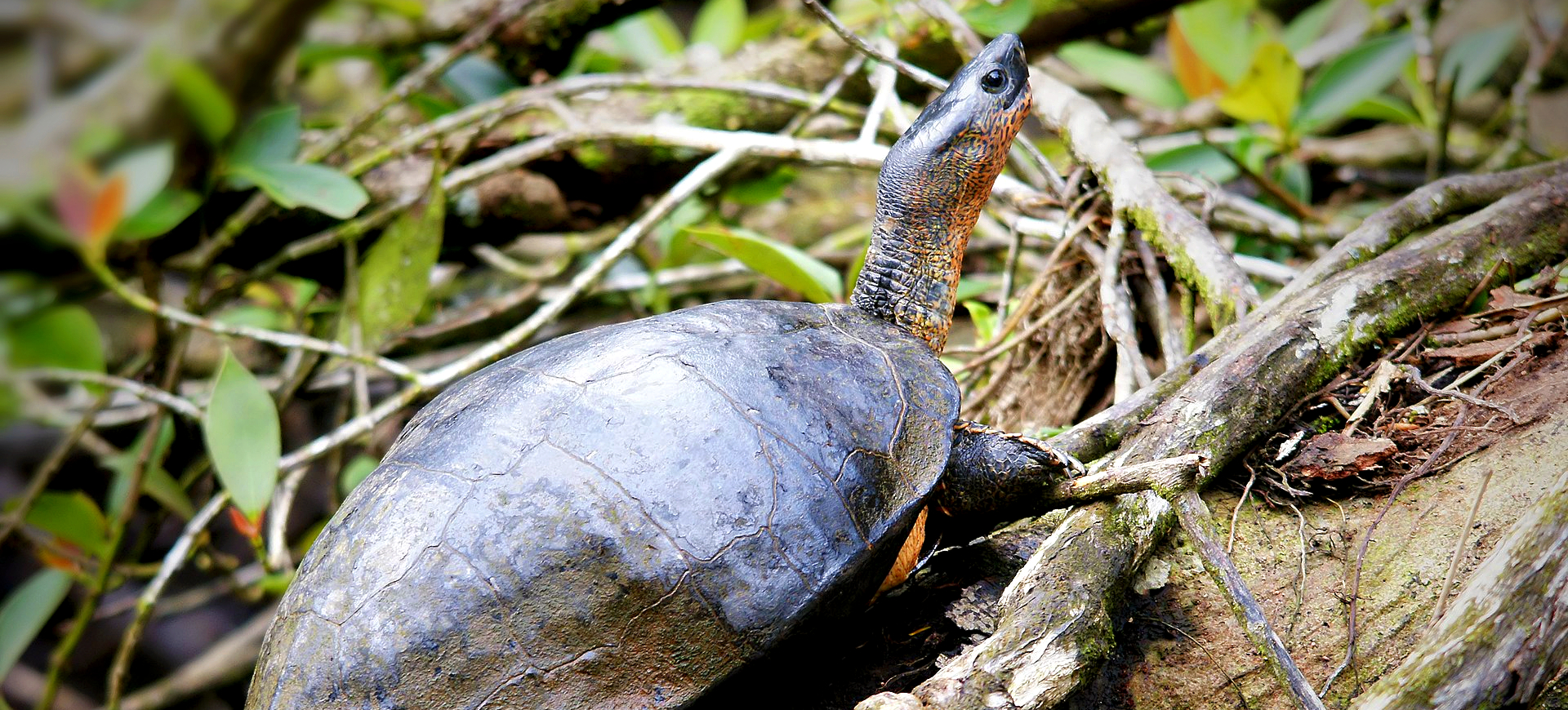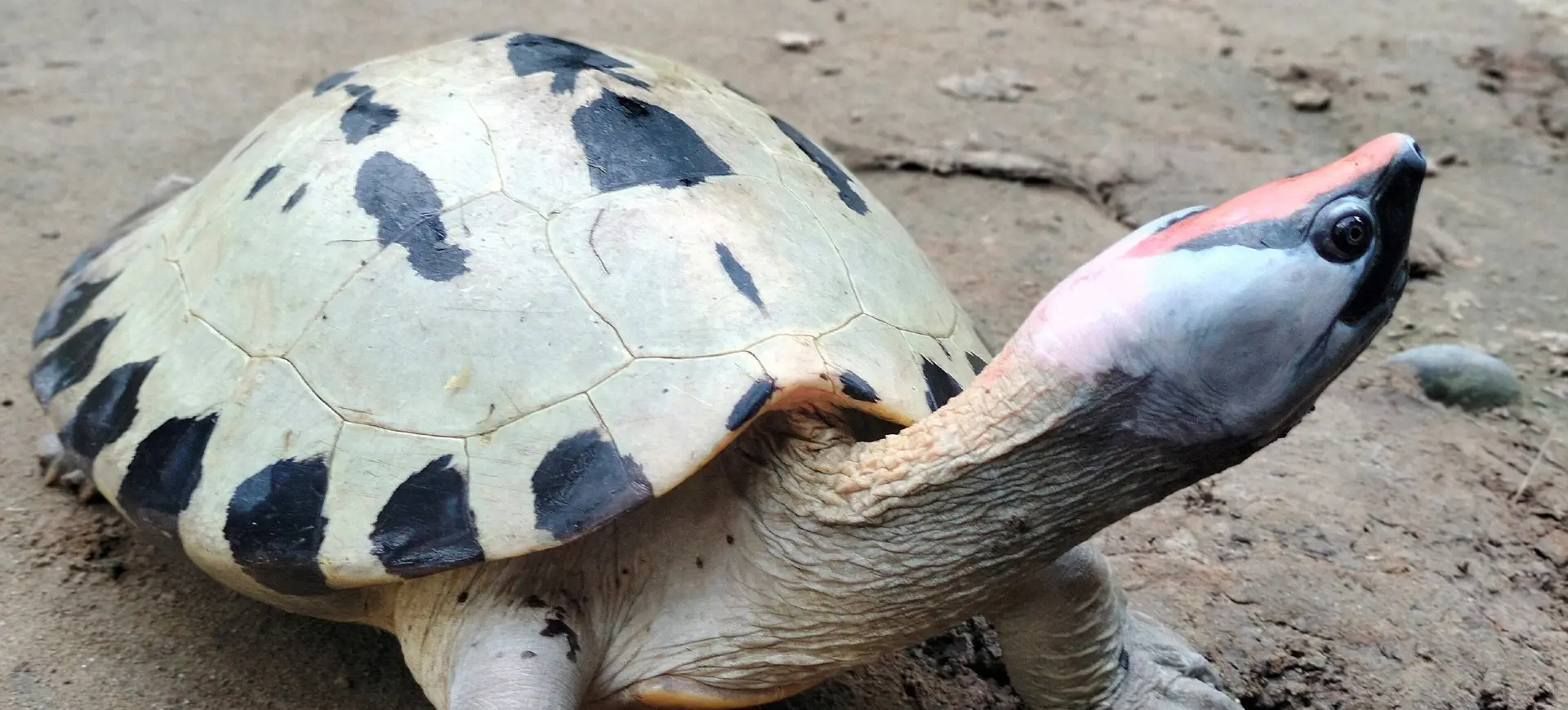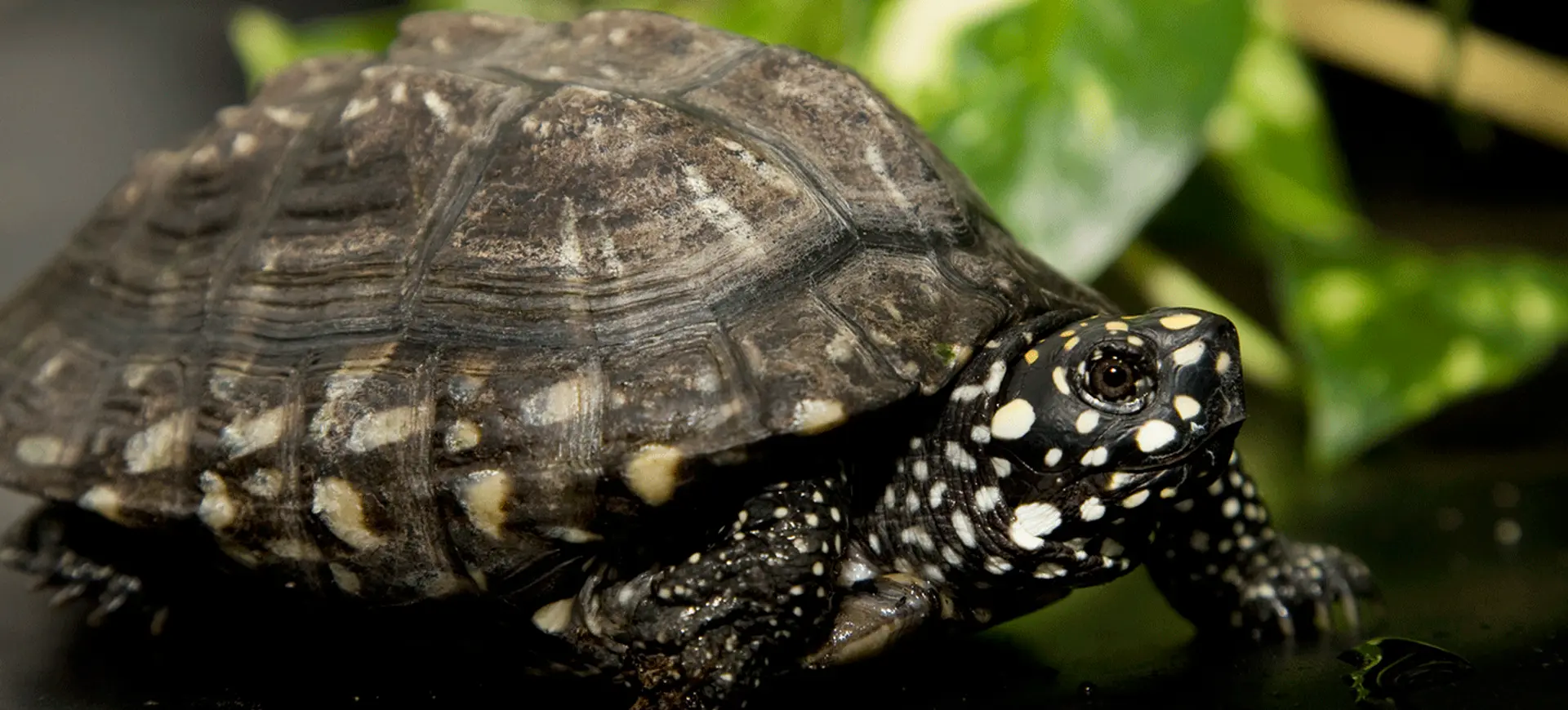Overview
The Yellow-headed Temple Turtle, scientifically named Heosemys Annandale, is a large freshwater turtle native to Southeast Asia. This species is known for its distinctive bright yellow or orange head, which stands out against its dark brown or black shell and body. These turtles are primarily aquatic in various freshwater habitats, including rivers, streams, marshes, and large ponds. They are named for their common occurrence in temple ponds and water gardens in Southeast Asia, where they are often revered and protected.
Adult Yellow-headed Temple Turtles have a robust, oval carapace that can reach substantial lengths, making them one of the larger turtle species in their region. Their carapace is typically dark brown or black, sometimes exhibiting lighter markings or spots. The plastron (underside) is usually yellowish, complementing its brightly colored head. The feet are webbed, aiding in their swimming ability, and they have strong, clawed toes for digging in muddy substrates.
The Yellow-headed Temple Turtle is predominantly herbivorous, feeding on aquatic plants, fallen fruits, and flowers. However, it is known to be opportunistic and may consume animal matter such as insects, fish, and carrion. This diet reflects its role in the ecosystem as both grazers and scavengers. Juveniles tend to have a more carnivorous diet, gradually becoming more herbivorous as they mature.
Taxonomy
Kingdom
Phylum
Class
Order
Family
Genus
Species
Type
Physical Description:
The Yellow-headed Temple Turtle is notable for its large size and strikingly colored head. An adult’s carapace can reach up to 60 centimeters (24 inches), with a high-domed shape and rugged texture. The carapace ranges from dark brown to black, often with yellowish or lighter speckles. The plastron is typically yellowish, contrasting sharply with the darker carapace.
The most distinctive feature of this species is its bright yellow or orange head, which is more pronounced in adults. The head coloration extends to the neck and is sometimes accompanied by black markings. Their limbs and tail are also dark, with webbed feet adapted for swimming. Males can be distinguished from females by their longer, thicker tails and the concave shape of their plastron.

Lifespan: Wild: ~20 Years || Captivity: ~35 Years

Weight: Male: 13-22 lbs (6-10 kg) || Female: 15-33 lbs (7-15 kg)

Length: Male: 18-20 inches (46-50 cm) || Female: 22-24 inches (56-60 cm)
Characteristic:
Native Habitat:
The Yellow-headed Temple Turtle is native to Southeast Asia, particularly in regions of Cambodia, Vietnam, Thailand, and Malaysia. Their natural habitats include slow-moving rivers, marshes, streams, and large ponds. These turtles prefer freshwater environments with abundant vegetation underwater and along the banks.
Their habitat choice reflects their need for both aquatic and terrestrial environments. They require water for feeding and swimming and land for basking and nesting. The presence of these turtles in temple ponds highlights their adaptability to human-modified environments where they are often protected.
Climate Zones:
Biomes:
Biogeographical Realms:
Continents:
Diet:
Diet & Feeding Habits:
The Yellow-headed Temple Turtle has a primarily herbivorous diet consisting of aquatic vegetation, fruits, and flowers. They often feed on leaves, stems, and fruit that fall into the water from overhanging trees. This diet reflects their role as important grazers in their aquatic ecosystems. In addition to plant matter, they occasionally consume animal-based food like insects, small fish, and carrion, especially when younger.
These turtles are known to forage along riverbanks and shallow waters. They have been observed using their strong jaws to tear apart vegetation and consume large amounts of fruit. Their feeding habits contribute to the dispersal of seeds and the maintenance of healthy aquatic plant populations. In temple ponds, they are often fed by monks or visitors, which can include a variety of fruits and vegetables.
Mating Behavior:
Mating Description:
The Yellow-headed Temple Turtle’s mating behavior typically occurs in water. During breeding, males pursue females and may aggressively interact with rival males. Courtship includes tactile and visual displays, such as the male stroking the female’s head and shell. Mating usually takes place in shallow waters.
Females lay eggs on land, often in sandy or muddy banks near their aquatic habitat. They dig nests with their hind limbs and lay up to 25 eggs. The incubation period varies depending on environmental conditions but generally lasts a few months. Hatchlings are independent of birth and immediately head toward the water.
Reproduction Season:
Birth Type:
Pregnancy Duration:
Female Name:
Male Name:
Baby Name:
Social Structure Description:
The Yellow-headed Temple Turtle is generally solitary, except during the mating season. Outside of breeding, these turtles are known to be quite independent, spending much time foraging alone. In temple ponds or areas with high food availability, they may be seen in groups, but this is more due to resource distribution than social preference.
During breeding, males can become territorial and engage in aggressive interactions. Females are solitary nesters and do not exhibit parental care after laying eggs. The social structure of these turtles is largely influenced by their environment and the availability of resources.
Groups:
Conservation Status:
Population Trend:
The population of Yellow-headed Temple Turtles in the wild has been declining due to several factors. Habitat loss due to agricultural expansion, urban development, and pollution has significantly impacted their natural environments. Additionally, overexploitation of the pet trade, traditional medicine, and consumption has greatly reduced their numbers in some areas.
The species faces challenges in its native range, with some populations being isolated and others facing intense pressure from human activities. Conservation efforts are crucial to prevent further decline and ensure this species’s survival in the wild. Protected areas and legal regulations are essential for their conservation.
Population Threats:
Major threats to the Yellow-headed Temple Turtle include habitat destruction, pollution, and illegal trade. Their habitats are increasingly lost to agricultural expansion, urbanization, and industrial development. Pollution from agricultural runoff, industrial waste, and domestic sewage also poses significant risks to their aquatic environments.
The illegal wildlife trade is a major threat, with these turtles being captured for the pet trade, traditional medicine, and as a food source. Their eggs are also collected for consumption, further impacting their reproductive success. Climate change poses an additional threat, potentially altering their habitats and breeding patterns.
Conservation Efforts:
Conservation efforts for the Yellow-headed Temple Turtle include habitat protection, legal enforcement, and awareness campaigns. Several countries within their range have implemented legal protections to prevent exploitation and trade. Conservation programs also focus on habitat restoration and the creation of protected areas.
Efforts are being made to raise awareness about this species’ importance and the threats it faces. This includes education programs in local communities and collaboration with religious institutions to protect turtles in temple ponds. Breeding programs in captivity are also being developed to support wild populations.
Additional Resources:
Fun Facts
- The Yellow-headed Temple Turtle is revered in Buddhist culture and is often found in temple ponds.
- They are one of the larger freshwater turtle species in Southeast Asia.
- Their bright yellow or orange heads make them easily recognizable.
- These turtles can live for several decades, with longer lifespans in captivity.
- They play a significant role in their ecosystems as grazers of vegetation.
- The species is known for its adaptability to human-modified environments.
- They are skilled swimmers but can be quite clumsy on land.
- Their diet changes from carnivorous as juveniles to herbivorous as adults.
- The Yellow-headed Temple Turtle is often associated with Buddhist temples, where it is considered auspicious.
- Their bright yellow head makes them one of the most visually striking turtle species in Southeast Asia.











